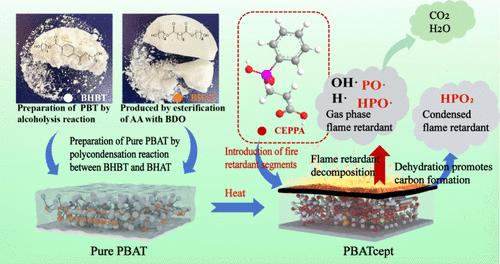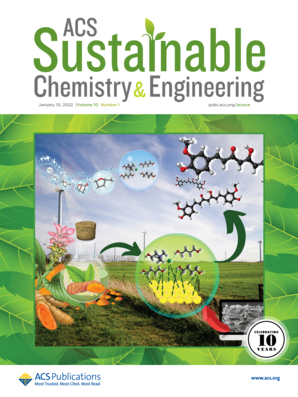Preparation of PBAT Copolyesters with Flame Retardant and Degradable Functions through PBT Chemical Alcoholysis and Closed-Loop Recycling
IF 7.1
1区 化学
Q1 CHEMISTRY, MULTIDISCIPLINARY
引用次数: 0
Abstract
The issue of fire hazard safety with regard to materials is of great concern. Polybutylene terephthalate/butylene terephthalate (PBAT) is the most extensively researched and utilized biodegradable material. However, the absence of flame-retardant chain segments in its molecular structure poses a significant environmental safety hazard. Our team utilizes the reversibility of the polymerization reaction of PBT (polybutylene terephthalate) materials and a chemical recycling process to degrade PBT into BHBT (butylene terephthalate), a raw material for the preparation of PBAT. At the same time, together with the halogen-free and environmentally friendly flame-retardant CEPPA (3-hydroxyphenylphosphinyl-propanoic acid) and BHAT (butylene glycol adipate), we design and produce an environmentally friendly and highly efficient halogen-free flame-retardant PBAT copolyester (PBATcept). The closed-loop recycling of nonbiodegradable PBT materials into small-molecule oligomers (BHBT) and oligomers into PBATcept was realized. The successful introduction of CEPPA into the PBAT chain segment was demonstrated to result in a reduction in the crystalline properties of PBATcept and an improvement in transparency and flame retardancy. The introduction of 5.0 mol % CEPPA resulted in a tensile strength of 10.93 ± 0.97 MPa and an elongation at break of 830.40 ± 48.25% for PBATcept5.0. Furthermore, the LOI value is 32.0%, and the UL-94 rating is V-0. CEPPA exerts synergistic flame-retardant effects of gas-phase flame retardancy and condensed-phase flame retardancy in PBATcept. During combustion, CEPPA undergoes preferential decomposition, generating nonflammable gases (H2O and CO2) to impede combustion and dilute the concentration of flammable gases. Concurrently, it forms a dense carbon layer on the surface of the polymer, which mitigates the safety hazards associated with PBAT due to fire. Furthermore, the preferential hydrolysis of the flame retardant enhances the biodegradation performance of PBATcept. The relative biodegradation rate can reach 33.92% after 30 days when the addition amount of CEPPA is 10.0 mol %.

通过 PBT 化学烷基溶解和闭环回收制备具有阻燃和降解功能的 PBAT 共聚物
材料的火灾危险安全问题备受关注。聚对苯二甲酸丁二醇酯/对苯二甲酸丁二醇酯(PBAT)是研究和使用最广泛的生物降解材料。然而,由于其分子结构中没有阻燃链段,因此对环境安全构成了极大的威胁。我们的团队利用 PBT(聚对苯二甲酸丁二醇酯)材料聚合反应的可逆性和化学回收工艺,将 PBT 降解为制备 PBAT 的原材料 BHBT(对苯二甲酸丁二醇酯)。同时,与无卤环保阻燃剂 CEPPA(3-羟基苯基膦酰基丙酸)和 BHAT(己二酸丁二醇酯)一起,设计并生产出一种环保高效的无卤阻燃 PBAT 共聚聚酯(PBATcept)。实现了将不可生物降解的 PBT 材料转化为小分子低聚物(BHBT),再将低聚物转化为 PBATcept 的闭环循环。实验证明,在 PBAT 链段中成功引入 CEPPA 可降低 PBATcept 的结晶特性,提高透明度和阻燃性。引入 5.0 mol % CEPPA 后,PBATcept5.0 的拉伸强度为 10.93 ± 0.97 MPa,断裂伸长率为 830.40 ± 48.25%。此外,LOI 值为 32.0%,UL-94 等级为 V-0。CEPPA 在 PBATcept 中发挥了气相阻燃和凝聚相阻燃的协同阻燃效果。在燃烧过程中,CEPPA 会发生优先分解,产生不可燃气体(H2O 和 CO2),阻碍燃烧并稀释可燃气体的浓度。同时,它还会在聚合物表面形成一层致密的碳层,从而减轻 PBAT 因起火而带来的安全隐患。此外,阻燃剂的优先水解也提高了 PBATcept 的生物降解性能。当 CEPPA 的添加量为 10.0 mol % 时,30 天后的相对生物降解率可达 33.92%。
本文章由计算机程序翻译,如有差异,请以英文原文为准。
求助全文
约1分钟内获得全文
求助全文
来源期刊

ACS Sustainable Chemistry & Engineering
CHEMISTRY, MULTIDISCIPLINARY-ENGINEERING, CHEMICAL
CiteScore
13.80
自引率
4.80%
发文量
1470
审稿时长
1.7 months
期刊介绍:
ACS Sustainable Chemistry & Engineering is a prestigious weekly peer-reviewed scientific journal published by the American Chemical Society. Dedicated to advancing the principles of green chemistry and green engineering, it covers a wide array of research topics including green chemistry, green engineering, biomass, alternative energy, and life cycle assessment.
The journal welcomes submissions in various formats, including Letters, Articles, Features, and Perspectives (Reviews), that address the challenges of sustainability in the chemical enterprise and contribute to the advancement of sustainable practices. Join us in shaping the future of sustainable chemistry and engineering.
 求助内容:
求助内容: 应助结果提醒方式:
应助结果提醒方式:


